
AP Photo/David Goldman
- After two months of declining participation, the number of women in the labor force grew by 251,000 in October.
- Labor Secretary Marty Walsh told Insider "we could see even more gains" with the passage of Biden's reconciliation bill.
- Even so, women might be waiting to get their children vaccinated or for affordable childcare to return.
The economy began roaring back in October, with the Bureau of Labor Statistics' monthly report showing that the country added 531,000 jobs.
It was a strong showing, coupled with revisions that showed August and September weren't as bad for job growth as originally reported.
And women – who have disproportionately borne the brunt of pandemic-induced job losses – got 57% of those jobs gained last month, according to an analysis from the National Women's Law Center. Hundreds of thousands of women also rejoined the labor force – which, paradoxically, made their unemployment rate go up as more women went on the job search. The labor force includes those who are both working and actively looking for work.
The report also reflects the first month that many children returned to school or childcare. It comes right as Democrats finally hash out and vote on a social-spending plan that would pour billions into making childcare more affordable and better paid.
"In this report, women make up half the gains and I mean, there's no coincidence," Labor Secretary Marty Walsh told Insider. "A lot of it is due to school starting."
Nick Bunker, economic research director at Indeed, said likely factors for more women joining the labor force last month could be school. He added maybe there were large gains in the industries that hire a high share of women.
As seen in the following chart, 251,000 women aged 20 and over joined the labor force in October. This comes after two consecutive months of labor force exits for women. On the other hand, 158,000 men aged 20 and over left the labor force after four consecutive months of men entering the labor force.
Women's labor force participation rate ticked up, while the rate for men ticked down slightly:
The numbers are solid, but there's still concerns
"I think it's a mixed bag," Jasmine Tucker, the director of research at the National Women's Law Center, told Insider. The gains were a good sign, as was the labor force participation, but Tucker noted that a big chunk of the jobs added for women came from retail and leisure and hospitality.
"I really am concerned about the quality of some of the jobs that have come back for women and whether they have worker protections, whether they can unionize," Tucker said.
Leisure and hospitality made up a large share of the job gains seen in October, and most of this strong gain was from women. According to the National Women's Law Center, women made up 58.5% of the 164,000 leisure and hospitality jobs gained last month. Women make up over half of leisure and hospitality employment as of October. Overall, gains were seen in most industries last month:
And those gains were not even across all women. 52,000 Black women left the labor force, even as white women and Latina women rejoined in droves.
"Black women face a lot of discrimination in the hiring practice, just getting hired by employers at all," Tucker said. "So if Black women have been unemployed for long periods of time and they get discouraged, they could decide to leave the labor force."
Big changes could be coming with vaccines for kids and the social spending plan
Just this week, kids ages five to 11 became eligible for COVID-19 vaccines. Tucker said that could be a "good sign" for women. Some may have stayed back out of concern for their kids in that age range, and could start trickling back into the labor force.
But women reentering the labor force will also need accessible and affordable childcare. That's where Biden's social spending proposal - which includes $400 billion towards childcare - comes in.
Walsh said "we could see even more gains" with the reconciliation bill.
"That's one area we can really grow in a big way as we continue moving forward here," Walsh said. "Good, strong quality childcare."
Tucker stressed that no one thing alone will get women back; childcare is one piece of the puzzle, as is paid leave. Of course, vaccines will do their part too. For now, she's looking ahead to see what happens.
"I think something to keep an eye on for January, as we start up that second semester, is whether more women are going to come back to the labor force - because they can get their kids enrolled in school, in-person learning because they're vaccinated, because they feel more comfortable doing so."
